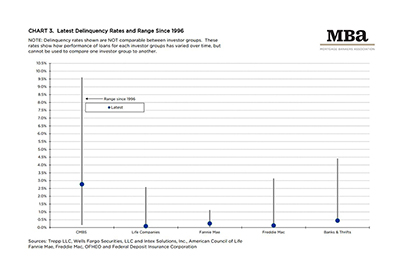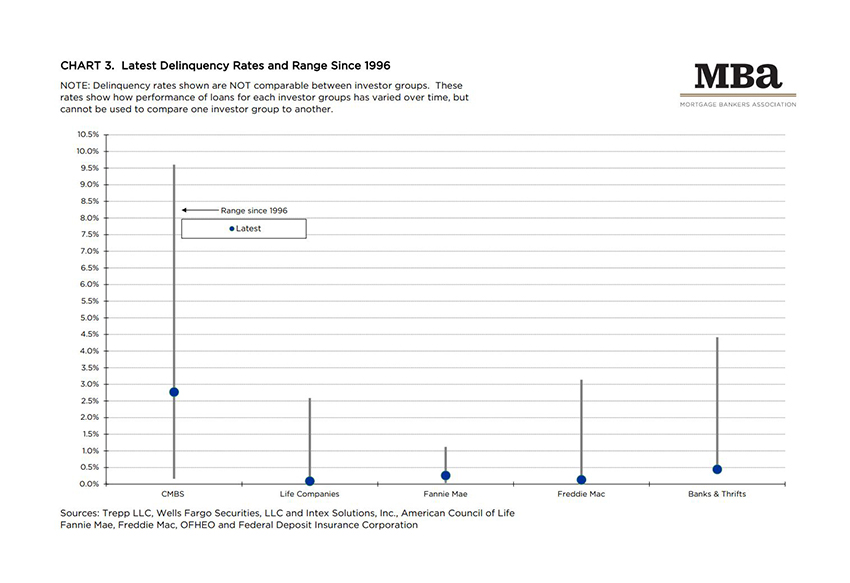
MBA: 3Q Commercial/Multifamily Mortgage Delinquencies Remain Low

Commercial and multifamily mortgage delinquencies showed little movement in the third quarter, according to the Mortgage Bankers Association’s latest Commercial/Multifamily Delinquency Report.
Based on the unpaid principal balance of loans, delinquency rates for each group at the end of the third quarter were as follows:
- Banks and thrifts (90 or more days delinquent or in non-accrual): 0.44 percent, a decrease of 0.05 percentage points from the second quarter;
- Life company portfolios (60 or more days delinquent): 0.09 percent, an increase of 0.05 percentage points from the second quarter;
- Fannie Mae (60 or more days delinquent): 0.26 percent, a decrease of 0.08 percentage points from the second quarter;
- Freddie Mac (60 or more days delinquent): 0.13 percent, an increase of 0.06 percentage points from the second quarter; and
- CMBS (30 or more days delinquent or in REO): 2.77 percent, a decrease of 0.18 percentage points from the second quarter.

“The delinquency rate for mortgages backed by commercial and multifamily properties remained low at the end of the third quarter,” said Jamie Woodwell, MBA Head of Commercial Real Estate Research. “For example, the share of bank-held CRE loan balances that were delinquent has only been lower once – just before the onset of the COVID-19 pandemic – in the series’ 30-year history.”
Woodwell noted, however, conditions that pushed delinquency rates to these near-record lows have been shifting. “We expect to see some stress work its way back into some loans. Very slight increases during the third quarter in the delinquency rates of life company and Freddie Mac loans may signal the beginning of these trends.”
The MBA quarterly analysis looks at commercial/multifamily delinquency rates for five of the largest investor-groups: commercial banks and thrifts; commercial mortgage-backed securities;, life insurance companies; and Fannie Mae and Freddie Mac. Together, these groups hold more than 80 percent of commercial/multifamily mortgage debt outstanding. MBA’s analysis incorporates the measures used by each individual investor group to track the performance of their loans. Because each investor group tracks delinquencies in its own way, delinquency rates are not comparable from one group to another. As an example, Fannie Mae reports loans receiving payment forbearance as delinquent, while Freddie Mac excludes those loans if the borrower is in compliance with the forbearance agreement.
Construction and development loans are generally not included in the numbers presented in this report but are included in many regulatory definitions of ‘commercial real estate’ despite the fact they are often backed by single-family residential development projects rather than by office buildings, apartment buildings, shopping centers, or other income-producing properties. The Federal Deposit Insurance Corp. delinquency rates for bank and thrift held mortgages reported here do include loans backed by owner-occupied commercial properties. Differences between the delinquencies measures are detailed in Appendix A.
Click here to download the latest report.
To better understand the ways the COVID-19 pandemic is and is not affecting commercial mortgage performance, MBA worked with its servicer members to develop the CREF Loan Performance Survey. For more information on the most recent results and the historical series, click here.
